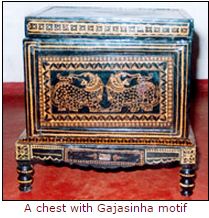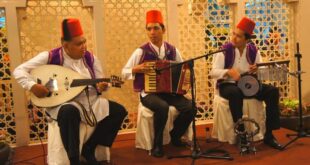The lac-workers of Hapuvida
by ASIFF HUSSEIN
 Lac work is certainly one of the most beautiful forms of art known to man. Be it flag poles or spear handles, candle holders or jewellery boxes, little round tables or large wall clocks, items worked in lac exude a beauty unmatched by any other form of art. Although lac work was formerly undertaken in a number of villages in both the upcountry and the maritime provinces, it is today largely confined to the village of Hapuvida in the Matale district. Here as well as in the adjoining village of Leliambe peopled by some settlers from Hapuvida, workers in lac turn out some extremely charming handicrafts as they have been doing for generations.
Lac work is certainly one of the most beautiful forms of art known to man. Be it flag poles or spear handles, candle holders or jewellery boxes, little round tables or large wall clocks, items worked in lac exude a beauty unmatched by any other form of art. Although lac work was formerly undertaken in a number of villages in both the upcountry and the maritime provinces, it is today largely confined to the village of Hapuvida in the Matale district. Here as well as in the adjoining village of Leliambe peopled by some settlers from Hapuvida, workers in lac turn out some extremely charming handicrafts as they have been doing for generations.
Arrow makers
The Lac-workers according to Ananda Coomaraswamy in his monumental Mediaeval Sinhalese Art (1908) belonged to a community known as I-Vaduvo or ‘Arrow-Makers’, a division of the Achari or Artisan Caste.The community probably took its name after the arrow-shafts which they are formerly supposed to have manufactured.
Besides Hapuvida, Coomaraswamy found lac work being carried out at Hurikaduva in Patha Dumbara, Pallekanda near Balangoda and Angalmaduva near Tangalle. The Matale work which the great scholar termed ‘by far the most distinctive’ has managed to survive into this century and all indications are that it would continue to do so provided it is given the necessary support by the state.
It is little known that the lac work done at Hapuvida today belongs to two distinct traditions, one, the distinctive niyapotu veda or fingernail work noticed by Coomaraswamy and the other, the more recently introduced pattal veda or lathe-worked lac work. The niyapotu veda, also known as mevara veda is by far the older form and is said by the villagers to have gained currency during the time of King Vijayapala of Godapola. It is still practised by a few families in Hapuvida and Leliambe to manufacture items such as bastam (staffs), kodi-miti (flag poles), hella-miti (spear handles) and poth-kamba (book covers). I-miti or arrow-shafts are also said to have been formerly produced in this manner.
This method as demonstrated to us by an elderly native of Leliamba, K.G. Kiriappu (83) consists of the lac being applied to the pole (in this case a bastama or staff by means of a lakada kura made of puvak wood (Areca catechu) after heating it in a gini kabala or charcoal fire. The lac is then smoothed with a tal leaf (Corypha umbraculifera) so that the pole is covered with a coating of red lac.
The yellow patterns at the base of the pole are formed by manually extracting threads of heated yellow lac and applying the end of the thread to the spot, after which a tiny piece is cut off with the fingernail, thus forming the desired pattern. Among the traditional patterns employed are the Gal-bindu (diamond-shaped spots such as we noticed in kiriappu’s bastama), palapetta (petal pattern), liyavela (creeper pattern), dela (net pattern) and patura (elongated isosceles triangles).
Resinous substance
The lac used today is however not the lakada used in the olden days, but rather shellac imported from countries like India, China and Indonesia. The lac used formerly is said to have been a resinous substance produced by a tiny insect known as Laksha Krumiya, its size being a sixteenth part of a mustard seed. Kiriappu who claims to have worked in lac since the age of 15 years recalled that in the olden days they used to bring trees like Keppetiya from Nayakumbura to obtain the lac.
This is corroborated by Coomarasawamy who says that Ceylon lac is the product of an insect called Kon lakada (Tachardia albizziae) occurring in trees such as keppetiya (Croton aromaticus), kon (Schleicheria trijuga) and hingu (Acacia caesia). The dyes used to mix with the lac were then largely natural and consisted of sadilingam (vermillion) for red, hiriyal (orpiment) or gokatu (Garcinia morella) for yellow, punil (indigo) or the leaf of the araliya (Plumeria acuminata) for green and andun deli (lamp soot) for black. Today however imported dyes such as Bayer Yellow, Red Coronation and Titanium are used.
We come next to the more recent form of lac work known as pattal veda said to have been imported from Lahore, India over 50 years ago by K.M. Abevardana, an ancestor of a well-established exponent of the craft, Saman Vijesiri of Hapuvida.
The method employed here is however very much similar to that described by Coomaraswamy as existing in the villages of Angalmaduva and Hurikaduva during his time. This method basically involves strips of lac being applied to the wood while revolving on a turning lathe, the heat of friction softening the lac and causing it to adhere to the wood. It involves a process known as the tattu kramaya where strips of coloured lac known as lakada pati are applied to the revolving wood one after the other so as to form layers of different colours, first yellow, then red and last of all black, at the end of which it is polished with a vetakeyya leaf (Pandanus fascicularis). A stylus known as ketayam katuva is then used to engrave the design, great skill being necessary to obtain the desired colours and effects.
Unique products
Among the more unique products turned out by Vijesiri may be included the halan heppuva (a globular jewellery container said to have been used by royalty to put their ornements in), serakkale (a small rounded table said to have been used by the King when consuming his meals) and pettagama (a large chest used to store valuables). Besides these he manufactures souvenirs, jewellery boxes and wall clocks all worked in lac.
The motifs employed include hansa puttu (pair of swans), bherunda pakshiya (double-headed eagle), gaja sinha (elephant-lion) and liya vela (creeper). Vijesiri who has several awards to his credit including the
 Asiff Hussein – Asiff Hussein Web Site
Asiff Hussein – Asiff Hussein Web Site




